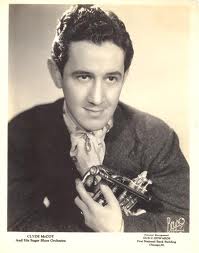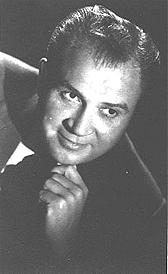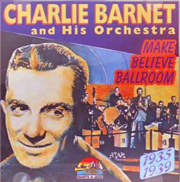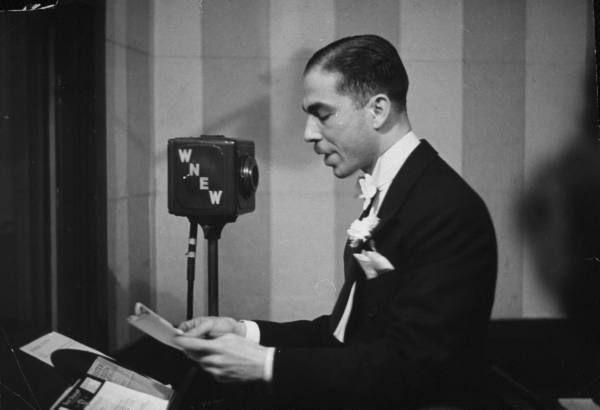Martin Block on WNEW’s “Make Believe Ballroom”
Early in 1935, recordings by the Clyde McCoy orchestra were being played repeatedly over WNEW by staff announcer Martin Block, who was filling time between news reports from the Lindbergh baby kidnapping trial in Flemington,  New Jersey. Accounts of what followed say that Block bought those recordings at a Manhattan music store with his own money because WNEW didn’t have any phonograph records, and because station manager Bernice Judas, who had conceded reluctantly to Block’s notion that playing recorded music between news reports would keep listeners tuned-in, would not put up any cash. Block was earning $25 a week, which was about the average weekly pay in the mid 1930’s among those Americans fortunate enough to be employed.
New Jersey. Accounts of what followed say that Block bought those recordings at a Manhattan music store with his own money because WNEW didn’t have any phonograph records, and because station manager Bernice Judas, who had conceded reluctantly to Block’s notion that playing recorded music between news reports would keep listeners tuned-in, would not put up any cash. Block was earning $25 a week, which was about the average weekly pay in the mid 1930’s among those Americans fortunate enough to be employed.
Block’s recorded music segments proved popular, and became regularly scheduled. He called his program the “Make Believe Ballroom,” One of those oft-repeated Clyde McCoy recordings, “Sugar Blues” became the “Ballroom.” theme.
Clyde McCoy “Sugar Blues” http://wnew1130com.web.siteprotect.net/wp-content/uploads/2010/12/sugar-blues.mp3]
The “Make Believe Ballroom” title and format were introduced to Block in 1932 when he found non-announcing work at radio station KFWB Los Angeles. Announcer Al Jarvis was becoming a star on KFWB at that time,  hosting a program called “The World’s Largest Make-Believe Ballroom,” which was divided into segments during which he would play a few recordings by one artist fostering the illusion that the performer was live on stage.
hosting a program called “The World’s Largest Make-Believe Ballroom,” which was divided into segments during which he would play a few recordings by one artist fostering the illusion that the performer was live on stage.
In an interview years later with the Canadian publication OC Register (Jarvis was born in Winnipeg) he was quoted as saying, “A few weeks after I got the job at KELW (which became KFWB) in 1932, I was hounding the owner-manager to let me air pop records instead of those electrical transcriptions. By using commercial records, I figured, I would not only have a more diversified program, but I could present some of the world’s great stars…that’s how the ‘Make Believe Ballroom’ was born.”
According to radio programmer and historian, Chuck Blore, and other accounts, Jarvis got the job on KELW by answering a newspaper ad: “Wanted. Man to talk on radio.” It’s said he talked four hours a day, reading from newspapers mostly and playing recordings on a wind-up phonograph, whose speaker he positioned in front of a microphone.
 “Sugar Blues” lasted less than a year as the theme music for Martin Block’s “Ballroom.” In 1936, Charlie Barnet and his “Barnet Modern-Aires” recorded “Make Believe Ballroom,” composed especially for Block. Barnet recalled that his “Ballroom” recording helped the band make a lot of friends in New York. Out in Los Angeles, on KFWB, Al Jarvis quickly started using the “Ballroom” theme for his own show.
“Sugar Blues” lasted less than a year as the theme music for Martin Block’s “Ballroom.” In 1936, Charlie Barnet and his “Barnet Modern-Aires” recorded “Make Believe Ballroom,” composed especially for Block. Barnet recalled that his “Ballroom” recording helped the band make a lot of friends in New York. Out in Los Angeles, on KFWB, Al Jarvis quickly started using the “Ballroom” theme for his own show.
As “The Ballroom” on WNEW grew in popularity, Block continued to use the Charlie Barnet “Ballroom” recording as his theme. But, in October, 1940, about two years after Barnet had created “Stay Up Stan, the All Night Record Man” as a theme for Stan Shaw on WNEW’s “Milkman”s Matinee,” his “Make Believe Ballroom” theme, was dropped by Block who reportedly wanted a new theme to reflect the changing pop chart sounds of the day. He got it from Glenn Miller, who even hired away Barnet’s singing group, the renamed “Modernaires.”
Words by Martin Block and Mickey Stoner, music by Harold Green.
Make Believe Ballroom Time – Glenn Miller Orch, Modernaires
http://www.youtube.com/watch?v=z6VrtmJHGMM
Throughout WWII, Martin Block enjoyed unprecedented success with WNEW, but in 1946 moved to Los Angeles and originated his three hour “Ballroom” on KFWB, with one of those hours being fed to Mutual for network syndication. Al Jarvis had since moved to KLAC. But, by October, 1947, according to “Billboard,” the deal between Martin Block and KFWB fell apart, because Block was unhappy with KFWB management which, in turn, complained that Block was “uncooperative” and too busy with his “other deals.” LA listeners, according to the ratings, were also unhappy with Block who sounded to some critics like a “know-it-all smart-alec New Yorker. Block returned to WNEW’s studios early in 1948 and hosted The Ballroom until in 1954, when contract talks failed, he departed WNEW’s studios a second and final time, and moved to ABC.
E.C.B.
It’s Make-Believe Ballroom Time
Put all your cares away
All the bands are here to bring a cheer your way
It’s Make-Believe Ballroom Time
And free to everyone
It’s no time to fret
Your dial is set for fun
Just close your eyes and visualize in your solitude
Your favorite bands are on the stands
And Mr. Miller puts you in the mood
It’s Make-Believe Ballroom Time
The hour of sweet romance
Here’s your make-believe ballroom
Come on, children, let’s dance!
It’s Make-Believe Ballroom Time
The hour of sweet romance
Here’s your make-believe ballroom
Come on, children, let’s dance!
Come on children, let’s dance
Photo credits
Martin Block: WNEW files
Al Jarvis: www.geocities.ws
Clyde McCoy: www.jazzagemusic.blogspot.com
Charlie Barnet Ballroom CD: www.oldies.com

